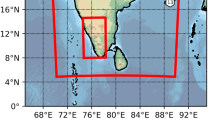Abstract
Unprecedented precipitation along with heavy falls occurred over many parts of India from 28th February to 2nd March 2015. Many of the stations of northwest and central India received an all time high 24 hr cumulative precipitation of March during this period. Even the national capital, New Delhi, broke all the previous historical 24 hr rainfall records of the last 100 years to the rainfall record in March 2015. Due to this event, huge loss to agricultural and horticultural crops occurred in several parts of India. In the present study, an attempt is made to understand the various meteorological features associated with this unprecedented precipitation event over India. It occurred due to the presence of an intense western disturbance (WD) over Afghanistan and neighbouring areas in the form of north–south oriented deep trough in westerlies in middle and upper tropospheric levels with its southern end deep in the Arabian Sea, which pumped huge moisture feed over Indian region. Also, there was a jet stream with core wind speed up to 160 knots that generated high positive divergence at upper tropospheric level over Indian region; along with this there was high magnitude of negative vertical velocity and velocity convergence were there at middle tropospheric level. It caused intense upward motion and forced lower levels air to rise and strengthen the lower levels cyclonic circulations (CCs)/Lows. Moreover, the induced CCs/Lows at lower tropospheric levels associated with WD were more towards south of its normal position. Additionally, there was wind confluence over central parts of India due to westerlies in association with WD and easterlies from anticyclone over north Bay of Bengal. Thus, intense WD along with wind confluence between westerlies and easterlies caused unprecedented precipitation over India during the 1st week of March 2015.













Similar content being viewed by others
References
Dimri A P and Dash S K 2012 Wintertime climate trends in the western Himalayas; Climatic Change 111 775–800.
Dimri A P 2005 The contrasting features of winter circulation during surplus and deficient precipitation over Western Himalayas; Pure Appl. Geophys. 162 2215–2237.
Dimri A P, Mohanty U C, Azadi M and Rathore L S 2006 Numerical study of western disturbances over western Himalayas using mesoscale model; Mausam 57 579–590.
Dimri A P and Mohanty U C 2009 Simulation of mesoscale features associated with intense western disturbances over western Himalayas; Meteorol. Appl. 16 289–308.
Hatwar H R, Yadav B P and Rama Rao Y B 2005 Prediction of western disturbances and associated weather over Western Himalayas; Curr. Sci. 88 913–920.
Holton J R 1992 An introduction to dynamic meteorology; Academic Press.
Kalnay E et al. 1996 The NCEP/NCAR Reanalysis 40-year Project; Bull. Am. Meteor. Soc. 77 437–471.
Kotal S D, Sen Roy S and Roy Bhowmik S K 2014 Catastrophic heavy rainfall episode over Uttarakhand during 16–18 June 2013 – observational aspects; Curr. Sci. 107 234–245.
Kumar N, Yadav B P, Gahlot S and Singh M 2015 Winter frequency of western disturbances and precipitation indices over Himachal Pradesh, India: 1977–2007; Atmósfera 28 67–74.
Lang J T and Barros A P 2004 Winter storms in the central Himalayas; J. Meteorol. Soc. Japan 82 829–844.
Puranik D M and Karekar R N 2009 Western disturbances seen with AMSU-band infrared sensors; J. Earth Syst. Sci. 118 27–39.
Raju P V S, Bhatla R and Mohanty U C 2011 A study on certain aspects of kinetic energy associated with western disturbances over northwest India; Atmósfera 24 375–384.
Rao Y P and Srinivasan V 1969 Discussion of typical synoptic weather situations: Winter western disturbances and their associated features; Forecasting Manual, IMD, India, part III, 1.1.
Rangachary N and Bandyopadhyay B K 1986 An analysis of the synoptic weather pattern associated with extensive avalanching in Western Himalaya; Proceedings of the Davos Symposium on Avalanche Formation, Movement and Effects. IAHS Publication No. 162 311–316.
Sen Roy S and Roy Bhowmik S K 2005 Analysis of thermodynamics of the atmosphere over northwest India during the passage of a western disturbance as revealed by model analysis field; Curr. Sci. 88 947–951.
Yadav B P, Kumar N and Tomar C S 2015 Analysis of heavy precipitation events over western Himalayan region; Int. J. Earth Atmos. Sci. 2 90–96.
Yadav R K, Rupa Kumar K and Rajeevan M 2012 Characteristic features of winter precipitation and its variability over northwest India; J. Earth Syst. Sci. 121 611–623.
Zafar Q and Rasul G 2009 Diagnosis and numerical simulation of a heavy rainfall event in winter over upper parts of Pakistan; Pakistan J. Meteorol. 5 81–96.
Acknowledgements
Authors are thankful to the Director General of Meteorology, India Meteorological Department for his encouragement and support. They sincerely thank the unknown reviewers for their valuable suggestions and comments to improve the quality of the paper.
Author information
Authors and Affiliations
Corresponding author
Additional information
Corresponding editor: K Rajendran
Rights and permissions
About this article
Cite this article
Kumar, N., Mohapatra, M. & Jaswal, A.K. Meteorological features associated with unprecedented precipitation over India during 1st week of March 2015. J Earth Syst Sci 126, 62 (2017). https://doi.org/10.1007/s12040-017-0842-y
Received:
Revised:
Accepted:
Published:
DOI: https://doi.org/10.1007/s12040-017-0842-y




